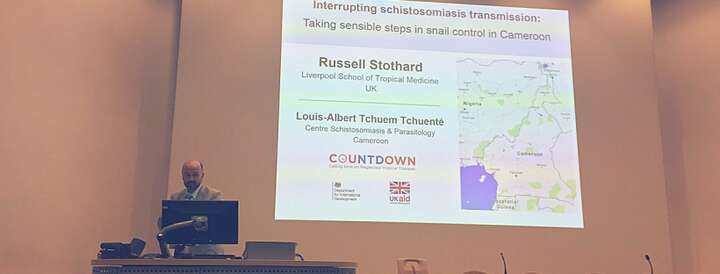
By Dr Louise Hamill and Professor Russell Stothard
Control of mosquito and blackfly vectors of lymphatic filariasis and onchocerciasis is a well-known strategy to augment ongoing disease elimination interventions in sub-Saharan Africa. Similarly, although not strictly considered vectors, control of certain freshwater snails is again attracting considerable public health attention for targeted interventions against schistosomiasis, especially in stubborn hot-spot foci. As part of the annual meeting agenda for the International Society for Neglected Tropical Diseases (ISNTD), the importance of vector control for several NTDs, malaria and arboviruses was thrown into sharp focus at their annual ISNTD bites forum.
Each year the ISNTD has a one-day specific workshop to bring together scientists and public health practitioners to highlight the best of current cutting edge endeavours. Held on the 19th July 2017, at the Institute of Child Health, this meeting featured leading experts from UK institutions, NGOs and commercial partners to discuss vector-control solutions for NTDs and discuss global health actions. The meeting showcased the latest research on vector control as well as providing a practical platform and international network to cement implementation partnerships in vector control.
Key COUNTDOWN activities were featured to highlight our work on snail and blackfly control in South West Cameroon, and mosquito control in Ghana. The morning’s keynote speaker, Professor Gabriella Gibson from the University of Greenwich, set the scene and gave a broad overview of how knowledge of vector behaviour is key to improving control and surveillance for vector-borne NTDs. Examples from research showed how knowledge of tsetse and mosquito host-seeking behaviour led to the implementation of innovative control strategies, highlighting how vital the link between basic research and applied implementation really is. This is particularly important as development of insect traps and control methods are adapted to take advantage of weaknesses in their behaviour, leading to a better knock-down of fly populations.
Highlighting medical malacology and the importance of snail intermediate hosts, Professor Russell Stothard gave the opening talk in the first session; “Taking sensible steps in snail control in the crater lakes of Barombi Kotto and Mbo, Cameroon”. Although snails are technically reservoir hosts for schistosomiasis, they form an essential step in the environmental development of the schistosome to release copious amounts of highly motile cercariae, the infective form to people. Therefore, strategies which target this intermediate snail host can lead to effective environmental disease control and elimination. Sometimes, snail control approaches share much with vector control, especially when chemical molluscicides are used. Prof Stothard gave an overview of the current state of snail control, before revealing the recent epidemiological picture of schistosomiasis in the crater lakes of South West Cameroon. Information derived from mapping of water contact patterns at an individual level, ecological snail studies and community wide schistosomiasis prevalence studies, have helped build this detailed picture. This knowledge forms a solid foundation of evidence upon which snail control and interruption of schistosomiasis transmission can be built. See https://youtu.be/dZhx_u8h1yQ.
After talks from representatives of Merck, Natural History Museum, The London School of Tropical Medicine and Hygiene and Oxitec, Prof Stothard chaired the first panel discussion of the meeting. Key repeat themes of integration, and increased knowledge emerged from these discussions;
“The more we know about vectors, the more we know about parasites and host interactions, then weird and wonderful ways to control vectors arise” – Ailie Robinson, London School of Hygiene and Tropical Medicine.
“We need to collaborate, learn from each other and use a combination of approaches to beat NTDs” Theresa Maier, Merck
“To facilitate interdisciplinary working, COUNTDOWN is breaking down silos between different research areas.” Russell Stothard, COUNTDOWN.
The panel discussion was recorded and can be viewed at https://youtu.be/maitrlR39IU.
These themes were further evident in the workshop on the MENTOR Initiative’s Integrated Vector Management Toolbox. In disaster and low resource areas, this workshop focused on effective, implementation ready strategies to control disease vectors in the most challenging of settings, led by Dr Richard Allan. Participants were encouraged to think outside the box, and to consider how a range of strategies could be tailored to particular settings and implemented at scale.
After lunch, there was a host of exciting talks on numerous topics, including a new drug target for tsetse control, improved performance management for NTD programs, Global Health Networks for Impact, and more fascinating discussion panels. It was also good to see other implementation research coming to the fore in the field of vector-borne NTDs, such as the digital monitoring platform Mango, presented by Greenmash; which can be easily tailored to suit specific project needs and has been used to make sure gender-disaggregated data is collected and readily available. This ties in with COUNTDOWN's work on gender equity in NTD control.
Reflecting on the day from a COUNTDOWN perspective, it was a great opportunity to keep up to date on vector control and other NTD research at ISNTD Bites, and to make sure COUNTDOWN was a key part of the presentations and the discussions. It was particularly pleasing to note that interdisciplinary working and innovation emerged as some of the key themes in the meeting, areas where COUNTDOWN is actively providing evidence for vector borne-NTDs through implementation research on lymphatic filariasis, onchocerciasis and schistosomiasis. Participating in this meeting has ensured that COUNTDOWN keeps a firm finger on the pulse of NTD implementation research, and that the project has a loud voice at an international forum to advocate for our research and approaches.
You can access the Storify of the event here.
